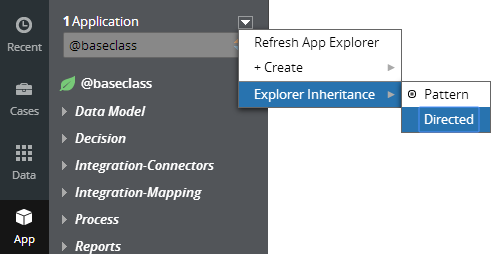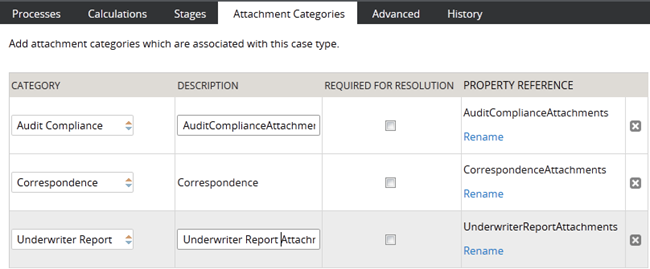Directed inheritance view in Application Explorer
Valid from Pega Version 7.1.5
You can now specify which inheritance model is used to populate classes in the Application Explorer. From the top level menu, use the “Explorer Inheritance” option to choose between:
- Pattern: only display class names whose prefix matches the root node class name.
- Directed: first display classes that explicitly name the root node as the parent class; then display classes with pattern inheritance.

By default, the Application Explorer loads using Pattern inheritance.
Attach Content control
Valid from Pega Version 7.1.5
The Attach Content control assists with attaching and uploading media files for Pega 7 applications. When in a mobile web browser, this control is limited to attaching image files only. Using a desktop browser with this control enabled launches the file browser, allowing users to select a type of capture mechanism and/or utilize an "attach file(s)" file selection prompt directly from their desktop.
View application quality metrics by data type
Valid from Pega Version 8.3
You can now view application quality metrics by data type on the Application Quality landing page. The new Data Types tab displays metrics for data types grouped by data objects, which enables you to more quickly understand the overall coverage of the application's integrations and interfaces.
For more information about data type metrics, see Application Quality landing page.
Create and view application settings in App Studio
Valid from Pega Version 8.3
View your application settings on the new Application settings landing page in App Studio. The landing page displays the categories that you specified for your application settings. If you did not specify a category for an application setting, the application setting appears in the Uncategorized category. Additionally, when you create a new data type, the Data type wizard automatically creates an application setting for the base URLs and the authentication profile. On the Environment settings page, you can edit the application setting to specify a new name or category or accept the default values.
For more information, see Viewing application settings in App Studio and Preparing your data for production.
Upgrade impact
After a successful upgrade, you see the new Application Settings option under Settings in App Studio.
What steps are required to update the application to be compatible with this change?
- If the label (Application Settings) conflicts with your existing extension, change the label by overriding the following field value:
PEGA-EXT- EXPEXPLORER-SETTINGS-APPSETTINGS PYCAPTIONIEXTENSION!LABEL - If you need to disable the landing page and prevent it from appearing in App studio, change the following toggle to No:
PegaRULES: DisableSettingsLandingPage
Standard page lists for attachments
Valid from Pega Version 7.1.5
The following new standard page lists allow you to easily reference attachments in your designs:
- pyAttachments — Holds a list of attachments of the current case.
- pyAttachmentCategoriesList — Holds a list of attachment categories of the current case. This property can be used to fetch the attachment information by category (pyAttachmentsByCategory).
- pyAttachmentsByCategory — Holds a list of attachments for the category set in the pyAttachmentCategory property in the current case.
When a user or system adds an attachment, the system automatically associates the page lists with the case, and populates them when the properties are referred to.
Creating an attachment category in a case type record automatically creates a property reference. See Redesigned Attachment Categories tab on Case Type record.
In addition, you validate the existence of an attachment by referencing the new function alias pxIsAttachmentOfCategoryInCase in a validate record. For example, you can use the properties and a validate record for building when logic that makes it necessary for a user to attach a document of category "SECCompliance" before the case can enter a stage.
Redesigned Attachment Categories tab
Valid from Pega Version 7.1.5
The Attachment Categories tab on the case type record has been redesigned as follows:
- In the Category field, you can associate case types with a case by selecting one in the application ruleset stack, or create a new one by typing a name in the field.
When you add a category to the list and save the record, the system automatically generates a page list property that that can be used to easily reference attachments by category.
In the example shown below, the page list property AuditComplianceAttachments can be used to access a list of attachments in the Audit Compliance category.
For ease of use during your design session, you can access this functionality using the "Attachments" option on the Case Designer Details tab.
The new function alias pxIsAttachmentOfCategoryInCase checks if an attachment of a particular category is attached to a case.
- Auto-Attach capabilities are deprecated but still supported. The tab displays a read-only list of attachments that were configured with this feature in previous releases.
- To remove this capability, delete the item.
- For new development, use the Attach Content smart shape in your process diagram.
Attachment migration from Pega database storage to a repository
Valid from Pega Version 8.3
You can now migrate case attachments from Pega database storage to a repository by using a wizard from Pega Platform™. This ability is useful, for example, when you migrate from an on-premises deployment to a Pega Cloud Services environment and you want to reduce the size of your Pega database and manage all your case attachments in a single location.
For more information, see Migrating case attachments to a repository.
Task board enhancements for improved tracking of tasks
Valid from Pega Version 8.3
App Studio and end-user portals, such as Case Manager, now provide an enhanced task board which helps you improve collaboration on task resolution. For example, you can create a checklist within a task, and then update the checklist to inform other users about the progress of the task. Attach content to a task to ensure that all users have the information that they need, and to make tasks more meaningful. Now you can also categorize tasks, and then filter them by category, to quickly access relevant information.
For more information, see Monitoring and tracking tasks in Dev Studio, Monitoring and tracking tasks in App Studio.
File sharing improvements in custom mobile apps
Valid from Pega Version 8.3
Case management in custom mobile apps that are built for Android and iOS using Pega Infinity Mobile Client™ is now improved with the enhanced Attach content control. You can now attach files of any type from the device storage and from cloud services, for example, Google Drive or iCloud, or from other mobile apps that are installed on the device. Additionally, you can share any file attachments, except for signature files, in external mobile apps.
For more information, see Enabling attaching files to an application.
Automatically generate OpenAPI Specification documentation for application REST APIs
Valid from Pega Version 8.3
You can now access a clear, standard view of all the REST APIs in your application by using autogenerated OpenAPI Specification (OAS) documentation. In App Studio, you can view the OAS documentation generated for application-specific REST APIs by using the new Application tab in the API channel. Additionally, service package rules now include an OpenAPI tab where you can view the automatically generated OAS documentation for all the REST services included in the service package. With these enhancements, you can easily find, visualize, and test the REST APIs in your application.
For more information, see Generating OpenAPI Specification documentation for application-specific REST APIs.

